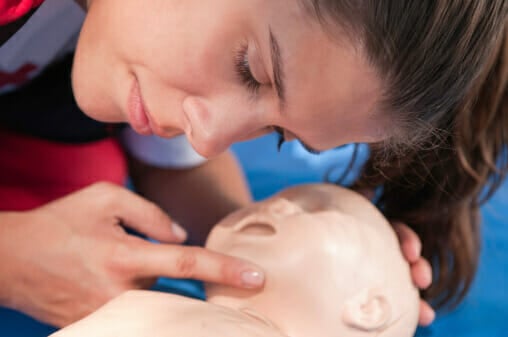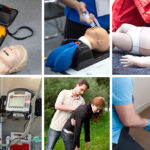CPR is a lifesaving technique used for anyone suffering from sudden cardiac arrest. But what is infant CPR and how does it differ from other types of CPR, such as child CPR and adult CPR?
The main difference between infant CPR and other forms is the depth of chest compressions you administer to infants. Their bone structure is more fragile than adults. You should only initiate 1 ½ inch chest compressions. On the other hand, adult CPR requires 2” chest compressions.
Additionally, infant CPR differs from adult CPR by its order of procedure. We will discuss these differences and what makes infant CPR unique further in this blog. At American CPR Care Association, we believe in educating more people around the world to instill the lifesaving skills needed to perform CPR.
Our online CPR certification program includes instructions on infant, child, and adult CPR and we offer convenient, affordable certification courses to ensure you maintain the lifestyle you want while learning how to save lives. Continue learning to learn more about what infant CPR is and how you could save a baby’s life using this technique.
What Is Infant CPR?
Infant CPR describes the procedural guidelines that bystanders should use to perform cardiopulmonary resuscitation on any child underneath the age of one year. This life saving procedure is performed during instances of cardiac arrest, a condition that causes the heart to stop due to an interrupted electrical connection between the brain and the heart.
Infants who suffer from cardiac arrest can sustain brain damage or die within minutes of cardiac arrest due to the lack of blood circulation. Whoever performs CPR should perform this procedure until the heartbeat and breathing return, or trained medical personnel arrive.
Reasons to Perform Infant CPR?
Cardiac arrest can result from the following medical emergencies:
- Trauma
- Choking
- Drowning
- Electrical and lightning shocks
- Severe infections
- Severe allergic reactions
The primary objective of CPR is to restore the heart to a normal rate and begin circulating blood again. Outcomes of CPR vary depending on how soon the bystander starts CPR. After the heart stops, a normal heart rate can return.
Possible Complications
The most common complication of infant CPR is breaking their ribs. Less common causes of injury include lung injuries such as pneumothorax and lung contusions, and abdominal organ injuries, such as hepatic, splenic, and gastric injuries.
How the Lungs and Heart Work
The lungs and the heart work in unison to deliver oxygen-enriched blood throughout the body. The lungs intake oxygen and the heart delivers the oxygen throughout the body via the blood.
The right side of the heart receives blood from the body and pumps it to the lungs. While in the lungs, the blood absorbs oxygen. After the blood absorbs oxygen, it returns to the heart and pumps throughout the body. Once the rest of the body absorbs oxygen, the blood returns to its heightened carbon dioxide state and the process begins again.
During cardiac arrest, the patient stops breathing and the heart stops beating, thus depriving the body of the oxygen it needs to survive.
How to Perform Infant CPR
Prior to performing CPR, you should tap the infant and call their name to see if they’re responsive. If the infant does not respond, follow these steps prior to beginning chest compressions:
- If someone is with you, they should call 911 immediately and you should direct them to search for an AED.
- If you are alone, you should begin CPR immediately, then call for help.
Performing CPR On a Child and Bab
Give 30 Chest Compressions
Place the infant on a flat surface. Place two fingers in the center of the infant’s chest just below the nipple line. Use the other fingers to encircle the baby’s chest toward the back for support. Press down 1 ½ inches at a rate of 100 to 120 BPM. Allow the chest to recover to its normal position after each compression.
Open the Airway
Gently tilt the head back taking care not to lift it back too far.
Perform Two Rescue Breaths
Cover the mouth and nose with your mouth to create a seal. Then, deliver two gentle breaths, watching for the chest to rise and release back to its normal position.
Continue Issuing CPR Until Medical Professionals Arrive
CPR keeps the blood flowing to the brain and other vital organs until medical help arrives and takes over the scene. You should also stop CPR if the following occurrences happen:
- You notice an obvious sign of life
- An AED is ready to use
- Another trained responder is available to take over compressions
- EMS personnel arrive and begin their care
- You are alone and too tired to continue
- The scene becomes unsafe
- You have performed approximately 2 minutes of CPR (5 sets of 30:2), you are alone and caring for baby, and you need to call 9-1-1
How Long Does Infant CPR Take?
The length of CPR varies depending on how fast medical help arrives. The duration of CPR also depends on the specific cause of cardiac arrest.
Will CPR Hurt the Infant?
Since the only time you should give CPR is if an infant is unconscious, CPR should not hurt the baby. However, injuries can occur during the process that the baby will feel after reviving.
How Long Does a CPR Class Take?
The duration of CPR classes varies depending on which type you enroll in. Most classes provide training in infant, child, and adult CPR/AED. However, some organizations provide First-Aid/CPR classes that take up to four-six hours.
Your class duration will also depend on whether you enroll with first-time or recertification students. If you enroll in a class with mostly recertification students, your class should be shorter than those filled with first-time students.
Taking online classes provides the most control over the duration of your CPR class. You can typically complete an online CPR class in as little as 30-90 minutes and you can tailor the schedule to your preferences.
If you are looking to become a CPR instructor, you should expect a more rigorous course regimen and longer class duration. These classes take as long as six hours to complete and you must complete a six-month monitoring period following your course completion to be considered a course instructor.
Finally, your course duration depends on which association you use. These associations structure their platforms differently and have different course requirements. Some associations will take longer than others due to these differences in curriculum.
Considerations
CPR is best performed by someone trained and certified from an accredited CPR course. The newest restrictions emphasize hands-only CPR, meaning the bystander only performs chest compressions and neglects to perform rescue breaths. It is important to note that while bystanders should perform CPR even if they are not certified, the guidelines presented in this article are by no means a substitute for certification.
Conclusion- What Is Infant CPR?
CPR splits into three categories: infant, child, and adult. While the basic steps to CPR remain the same, there are key differences bystanders should be aware of when deciding to perform CPR.
Infant CPR describes the correct procedures for anyone under the age of one years old. Child CPR applies to anyone between the ages 1-12, though you can typically use the same methods for anyone around the age of puberty. Adult CPR refers to the procedures used for anyone past puberty, the main difference being the depth of chest compressions bystanders should apply.
At the American CPR Care Association, we provide comprehensive CPR training for people of all ages. Our certified instructors and online classes make certification thorough and convenient, putting lifesaving skills in your hands and ensuring you get the most out of your CPR training.
Contact us today to enroll in our affordable CPR classes.







